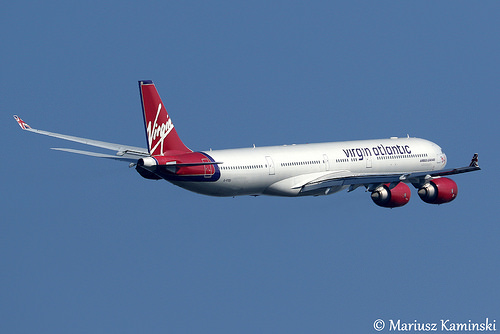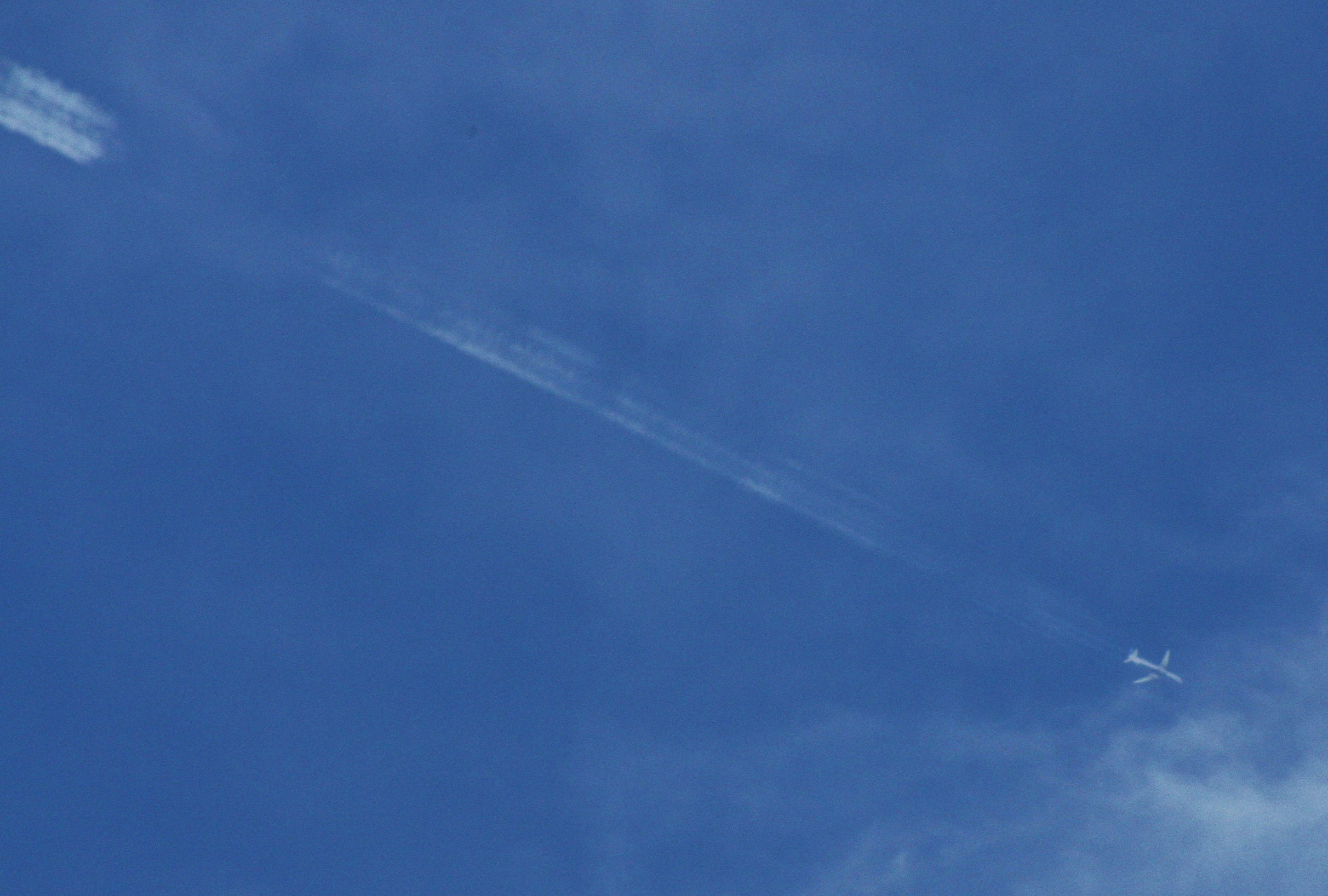If you are short on time, then I made a one minute video explaining this:
Source: https://www.youtube.com/watch?v=2bFfuIidCK0
Background: Infrared footage from the Chilean Navy appears to show some kind of flying object that briefly leaves a trail behind it.
http://www.huffingtonpost.com/entry..._us_586d37bce4b014e7c72ee56b?lciacn1ruwjkmx6r (.", "\.)
(Full footage can be seen here)At 1:52 pm, while filming the terrain, the technician observed a strange object flying to the left over the ocean. Soon both men observed it with the naked eye. They noticed that the velocity and the altitude of the object appeared to be about the same as the helicopter, and estimated that the object was approximately 35 to 40 miles (55-65 km) away. It was traveling W/NW, according to the Captain. The technician aimed the camera at the object immediately and zoomed in with the infrared (IR) for better clarity.
This looks like a plane, flying away from the camera considerably higher than the helicopter (somewhere around 15,000 to 25,000 feet), which briefly creates an aerodynamic contrail.
Based on analysis by @Trailblazer, @Trailspotter, myself, and others, There were only two planes possibly involved: IB6830 and LA330. The plane that initially seems to fit best is LA330, a two-engined A320, which was reported to be climbing through 20,000 feet at that exact visual position at 14:01:39.
https://planefinder.net/flight/LXP330/time/2014-11-11T17:01:39 UTC/speed/15.00^
While this seemed like a good fit just based on this overhead view, subsequent 3D analysis revealed that IB6830 (a four-engined A340) is actually a perfect match. IB6830 left earlier and was climbing out more to the south, nearer to the helicopter. At the time this was spotted (the very first sighting on the video, at 13:52:34) IB6830 was actually around 35 miles away. However it would very quickly get further away. By 13:57 IB6830 would be 65 miles away. This explains why it was not seen on radar (IB6830 was on radar, just not where they thought it was)
Initially, I had to extract the data for the track from Planefinder, but then I located the FlightAware GPS track. Using this, multiple other examples of IB6830's departure, and the official departure charts, I was able to create a track in google earth using actual GPS coordinates (blue) and estimated positions (orange).
Since we have timestamped GPS locations, we can now geolocate IB6830 and LA330 in Google Earth, and create views of frames from the helicopter video using the coastline and mountains to get the exact heading.
IB6830 is in exactly the right position. We can position both the planes and the chopper precisely with the GPS data, match the camera direction from the wide shot, and the position of IB6830 then matches exactly.
Here's a video showing how it matches up:
Source: https://www.youtube.com/watch?v=Uoqxr6AI7VQ
The two large blobs are glares, images from the heat of the engines (much smaller in reality). You can see this effect with some candles if you view them from a distance with an IR camera. I used the FLIR ONE to do this:
(Here's a video of the above experiment)
We can see how large the glares look at various stages of the path.
The flaring is more apparent if you look at it uninverted. The engines appear as two very bright lights
The aerodynamic contrail starts and stops in a similar way to the trail in this video (not a "chemtrail" though, this just a regular aerodynamic contrail)
Source: https://www.youtube.com/watch?v=cjy0NcUCTEc
There are a few different relevant images from the video:
This is a close-up of the object early in the video, and then a few frames later when the camera changes zoom, causing motion blur.
This shows that the plane is banked at this point - i.e. it is turning to the right. This matches the part of the track for IB6830 where it turns to the north, based on the time. The engine configuration is a perfect match. In the motion blurred frame on the right, the positions of the individual engines are clearly delineated. As shown earlier, it's also a perfect match for the plane's size and distance.
Compare it with this video of a plane taking off. It is much closer, however at the end of the video you see the two engines tilted at about the same angle as the "UFO" while the plane turns right.
At one point (9:08) they switch between the IR camera and a regular (visible light) camera. you can see the trail quite distinctly. It looks very like a contrail.
Why is it showing up as warmer? Aerodynamic contrails are essentially clouds, and at this altitude, they will be ice clouds, below freezing. They show up as darkly colored for the same reason that other clouds in the scene show up dark. It's simply the camera adjusting the exposure for the very cold sky. The engines are small so they don't affect the exposure much (and hence they glare). So the net result is that anything warmer than radiation coming from a clear sky will appear dark.
A few seconds later
It also seems a bit odd that there is very little change in the heading and elevation angles in the video. This becomes clear if you look at the angles and distances involved
The thin white lines here connect the chopper and the plane at equal times, as you can see the heading angle between them does not change much.
The altitude of the plane varies from ~5000m to 9000m, while the distance varies from 70km to 170km, the chopper is about 1400m, we can draw a diagram to see the angles
As you can see there is very little change from the start (2.93°) to the end (1.94). Basically, it should vary from about 3° to about 2° (appearing to be descending faster at the start)
[Note: this top post will be updated with information from the discussion below, so some of what follows may seem repetitive]
References: IPACO Report^
Frequently Asked Questions
Q: If it was a plane then why did it not respond to hailing
A: A pilot familiar with Santiago departure responds:
The helicopter seems to have tried to call on 121.5. There are a couple of problems with that, Most aircraft don't set that frequency until some time after takeoff which can vary from airline to airline, and if they were listening, unless whoever was calling used their callsign, they wouldn't respond.
Q: Why did it not show up on radar?
They were looking for a low flying object south of the airport about 35 miles away, by the time they looked it was at a high altitude and 65 miles away. The plane actually does show up on radar in data supplied by CEFAA
Q: How can it be a contrail cloud if it's as hot as the engine?
A: It's not as hot as the engines, it's a similar color in the IR to other clouds in the images. It's just a dense cloud which is a lot warmer than the far background sky. Even if they were dumping boiling water it would have been atomized by the 300 mph wind into a cloud and cooled to ambient temperature in seconds.
Q: Don't contrails only form above 30,000 feet?
A: That's where exhaust contrails are most frequent. However, this looks exactly like a semi-persistent aerodynamic contrail which often form on climbing aircraft between 20,000 to 30,000 feet (and sometimes lower).
Q: Why did you change from LA330 to both LA330 and IB6830 and then to just IB6830?
There were only ever two possible planes. LA330 looked better when simply viewing the tracks from above. But later 3D recreation showed that IB6830 (flying a similar path) was a better fit. LA330 still looked like a good fit for the final shot, but more detailed analysis of the path eventually showed it could only be IB6830
Q: Why should we trust your theory over the experts?
A: I could argue I'm an expert too (at identifying planes and contrails), or that the CEFAA lacks expertise in some areas, or that even experts make mistakes. However let's drop that "argument for authority", and look at facts you can verify yourself.
We have some very solid verifiable evidence in
- The helicopter video with timestamps and GPS coordinates.
- The IB6830 ADS-B track with timestamps and GPS coordinates.
- IB6830 is in the right place at the right time
- IB6830 is going in the right direction
- IB6830 banks when the "UFO" banks,
- IB6830 would create a visual thermal signature the same size as in the video.
- IB6830 engine configuration matches the glares seen in the banking and then climbing
- The size of IB6830's thermal signature shrinks proportional to its distance, matching the video.
- Contrails derived from the IB6830's track would have the same apparent size as in the video.
See also:
- Explained: Contrails Appear "Hot" in Thermal Imaging because the Sky Appears Very Cold
- Recreating the missing section of IB6830's ADS-B track
http://www.huffingtonpost.com/entry...deo-is-it-a-plane_us_587e7277e4b06a0baf6490ef (http://archive.today/gC6Q3)
Attachments
Last edited:


 IMG_0143
IMG_0143